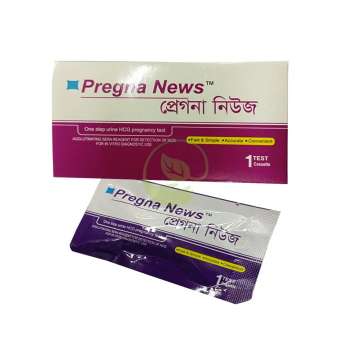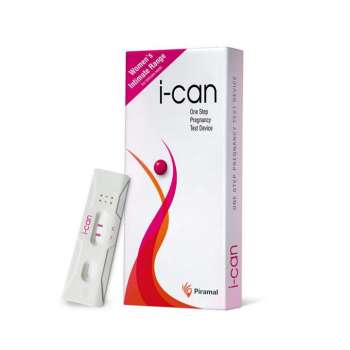Pregnancy test
Everything You Need to Know About Pregnancy Tests: Types, Timing, and Accuracy
Pregnancy tests are designed to detect whether your body is producing a specific hormone called human chorionic gonadotropin (hCG). This hormone is generated right after a fertilized egg implants itself in the wall of a woman’s uterus. Generally, this implantation occurs about six days after fertilization, though this timing can vary. Once the implantation is complete, hCG levels begin to rise rapidly, making it possible for pregnancy tests to detect its presence in either urine or blood.
Knowing when and how to take a pregnancy test can be crucial for an accurate result. In this article, we’ll walk you through the types of pregnancy tests, the best time to take them, and their overall accuracy, helping you make informed decisions when checking for pregnancy.
How Pregnancy Tests Work
Pregnancy tests are used to detect the presence of the hormone hCG. This hormone is produced by cells that form the placenta, which nourishes the embryo after it attaches to the uterine lining. hCG begins to appear in the body right after implantation, and its levels increase significantly in the initial days and weeks of pregnancy. It is this rapid hormone surge that triggers most early pregnancy symptoms, such as nausea, fatigue, and breast tenderness.
When to Take a Pregnancy Test
After a Missed Period: The best time to take a pregnancy test is typically on or after the day your next period is due. If you are unsure when your next period is due, wait at least 21 days after you last had unprotected sex before taking the test.
Early Testing: Some highly sensitive pregnancy tests can detect pregnancy as early as eight days after conception, before a missed period. These early-detection tests are designed to pick up lower levels of hCG in the urine.
Morning Testing: For best accuracy, it’s recommended to take a urine test in the morning, especially if testing early. First-morning urine tends to have the highest concentration of hCG, which makes it easier for the test to detect.
Types of Pregnancy Tests
Pregnancy tests fall into two broad categories based on the sample they analyze: urine tests and blood tests.
1. Urine Pregnancy Tests
Urine pregnancy tests are the most commonly used method, available both as home tests and in clinics. They detect the presence of hCG in the urine and can be performed in one of two ways:
Dipstick Method: In this method, you collect your urine in a cup and then either dip the stick into the cup or use a dropper to place the urine on a special container.
Midstream Method: For this method, you place the test stick directly into your urine stream. This option is generally more convenient for home testing.
Results Interpretation: Urine tests show results through changes in color, appearance of lines, or symbols like plus (+) or minus (-). Modern digital tests simplify the process by displaying the results as “Pregnant” or “Not Pregnant” in words, eliminating any confusion.
Best Time for a Urine Test: The ideal time for taking a urine pregnancy test is on the first day of your missed period, usually about two weeks after conception. Testing too early can lead to a false negative. If you’re testing early, morning testing is recommended for better accuracy, as hCG levels are higher in the morning.
Accuracy: When performed correctly, urine tests can reach about 97% accuracy. They are popular due to their affordability, privacy, ease of use, and quick results. However, incorrect usage, testing too early, or dilution of urine (from excessive water intake) can result in false negatives.
2. Blood Pregnancy Tests
Blood pregnancy tests are less common but more sensitive compared to urine tests. They must be conducted in a clinic or laboratory and are often recommended by doctors if a home pregnancy test gives unclear results.
There are two main types of blood pregnancy tests:
Qualitative hCG Test: This test checks whether hCG is present in the blood and gives a simple yes or no answer. It’s usually done to confirm pregnancy.
Quantitative hCG Test (Beta hCG Test): This test measures the exact amount of hCG in the blood, which can help determine the age of the pregnancy and detect potential complications.
Accuracy: Blood tests can detect pregnancy earlier than urine tests—about 6-8 days after ovulation. They are more accurate and can measure even very low levels of hCG, but they take longer to process and are more expensive.
Factors Affecting Pregnancy Test Results
Several factors can influence the accuracy of both urine and blood pregnancy tests:
Timing: Testing too early (before the hCG levels have built up) can lead to false negatives.
Urine Dilution: Taking a urine test after consuming a lot of fluids can dilute hCG levels, making the test less reliable.
Medications: Certain fertility medications that contain hCG can lead to false positives in both urine and blood tests.
Ectopic or Chemical Pregnancy: In cases of an ectopic or chemical pregnancy, hCG levels may rise more slowly, leading to inconclusive test results.
Best Practices for Taking a Pregnancy Test
To maximize accuracy and reduce the chances of error, follow these tips when taking a pregnancy test:
Read the Instructions Carefully: Every brand has specific guidelines for timing and interpreting results.
Use the First Morning Urine: For early detection, use the first morning urine when hCG levels are more concentrated.
Wait the Recommended Time: After taking the test, wait for the recommended time to read the results. Checking too soon or too late can lead to incorrect interpretations.
Avoid Drinking Excessive Water Before Testing: This can dilute your urine, making it harder for the test to detect hCG.
Retest If Necessary: If you get a negative result but still experience pregnancy symptoms (such as a missed period, nausea, or breast tenderness), wait seven days and test again.
Consult Your Doctor for a Blood Test: If home tests continue to be unclear, consider a blood test for a more definitive answer.
When to See a Doctor
It’s important to see a healthcare professional if:
- You have a positive test result to start prenatal care.
- You have a negative result but continue experiencing symptoms of pregnancy.
- You experience symptoms such as severe abdominal pain, heavy bleeding, or dizziness, which may indicate complications like ectopic pregnancy.
Conclusion
Pregnancy tests are a helpful tool in determining pregnancy early, but understanding when and how to use them correctly is crucial for accurate results. Choosing between a urine or blood test depends on your needs, budget, and how soon you want to know. If in doubt, always consult with your healthcare provider for guidance and follow-up testing.
By following the recommended guidelines and paying attention to your body’s signals, you can ensure you get the most reliable results, setting the stage for a healthy and informed pregnancy journey.
In Bangla:
গর্ভাবস্থা পরীক্ষার সবকিছু: ধরণ, সময় এবং নির্ভুলতা
গর্ভাবস্থা পরীক্ষা মূলত আপনার শরীরে হিউম্যান কোরিওনিক গোনাডোট্রোপিন (hCG) নামক একটি হরমোনের উপস্থিতি শনাক্ত করতে ব্যবহৃত হয়। এই হরমোনটি তখন উৎপন্ন হয় যখন নিষিক্ত ডিম্বাণুটি মহিলাদের জরায়ুর প্রাচীরে সংযুক্ত হয়। সাধারণত, এই সংযুক্তি নিষেকের প্রায় ছয় দিন পরে ঘটে, যদিও সময়ের তারতম্য হতে পারে। সংযুক্তির পরপরই, শরীরে hCG-এর মাত্রা দ্রুত বাড়তে থাকে, যা প্রস্রাব বা রক্তের নমুনার মাধ্যমে গর্ভাবস্থার পরীক্ষা নির্ভুলভাবে করতে সাহায্য করে।
কখন এবং কীভাবে গর্ভাবস্থার পরীক্ষা করবেন তা জানলে সঠিক ফলাফল পাওয়া সহজ হয়। এই নিবন্ধে গর্ভাবস্থা পরীক্ষার ধরণ, সঠিক সময় এবং নির্ভুলতা সম্পর্কে বিস্তারিত আলোচনা করা হয়েছে, যা আপনাকে গর্ভাবস্থা পরীক্ষার সঠিক সিদ্ধান্ত নিতে সহায়তা করবে।
গর্ভাবস্থা পরীক্ষা কীভাবে কাজ করে?
গর্ভাবস্থা পরীক্ষা মূলত শরীরে hCG হরমোনের উপস্থিতি চিহ্নিত করে। এই হরমোনটি তখন উৎপন্ন হয় যখন নিষিক্ত ডিম্বাণুটি জরায়ুর প্রাচীরে সংযুক্ত হয় এবং প্লাসেন্টার গঠন শুরু হয়। hCG-এর মাত্রা গর্ভাবস্থার প্রাথমিক কয়েক সপ্তাহের মধ্যে দ্রুত বাড়তে থাকে। এই হরমোনের দ্রুত পরিবর্তনই গর্ভাবস্থার প্রাথমিক উপসর্গগুলি যেমন বমি বমি ভাব, ক্লান্তি এবং স্তনের কোমলতা সৃষ্টি করে।
কখন গর্ভাবস্থা পরীক্ষা করবেন?
মাসিক মিস হওয়ার পর: সাধারণত গর্ভাবস্থা পরীক্ষার সঠিক সময় হলো আপনার পরবর্তী মাসিকের তারিখ পেরিয়ে যাওয়ার দিন থেকে। যদি আপনি নিশ্চিত না হন যে আপনার পরবর্তী মাসিক কবে শুরু হবে, তাহলে শেষ অনিরাপদ যৌন মিলনের ২১ দিন পর পরীক্ষা করুন।
প্রাথমিক পরীক্ষা: কিছু সংবেদনশীল গর্ভাবস্থা পরীক্ষা গর্ভধারণের ৮ দিন পরে (যথা, মাসিক মিস হওয়ার আগেই) গর্ভাবস্থা সনাক্ত করতে সক্ষম। এই ধরনের প্রাথমিক পরীক্ষা কম পরিমাণে hCG-ও শনাক্ত করতে পারে।
সকালে পরীক্ষা করা: সর্বোচ্চ নির্ভুলতার জন্য, সকালে প্রথম প্রস্রাবের সময় গর্ভাবস্থা পরীক্ষা করা ভালো, কারণ সকালের প্রস্রাবে hCG-এর মাত্রা বেশি থাকে।
গর্ভাবস্থা পরীক্ষার ধরণ
গর্ভাবস্থা পরীক্ষার মূলত দুইটি ধরন রয়েছে: প্রস্রাব পরীক্ষা এবং রক্ত পরীক্ষা।
১. প্রস্রাব পরীক্ষা
প্রস্রাব পরীক্ষা সবচেয়ে বেশি ব্যবহৃত হয় এবং এটি ঘরে বা ক্লিনিকে করা যায়। এটি প্রস্রাবে hCG-এর উপস্থিতি চিহ্নিত করে এবং এটি দুটি পদ্ধতিতে করা যেতে পারে:
ডিপস্টিক পদ্ধতি: এই পদ্ধতিতে একটি কাপের মধ্যে প্রস্রাব সংগ্রহ করে, টেস্ট স্টিকটি সেই প্রস্রাবে ডুবিয়ে রাখতে হয় অথবা একটি ড্রপার ব্যবহার করে প্রস্রাবকে একটি নির্দিষ্ট অংশে রাখতে হয়।
মিডস্ট্রিম পদ্ধতি: এই পদ্ধতিতে প্রস্রাবের সময় সরাসরি টেস্ট স্টিকটিকে প্রস্রাবের ধারা ধরে রাখা হয়, যাতে এটি প্রস্রাবের মাধ্যমে সরাসরি পরীক্ষা করতে পারে।
ফলাফল পড়া: প্রস্রাব পরীক্ষা সাধারণত রং পরিবর্তন, একটি নির্দিষ্ট চিহ্ন (যেমন, + বা -) বা লাইন দেখানোর মাধ্যমে ফলাফল নির্দেশ করে। আধুনিক ডিজিটাল পরীক্ষাগুলো আরও সহজ: “গর্ভবতী” বা “গর্ভবতী নন” এমন লেখার মাধ্যমে ফলাফল প্রদর্শিত হয়।
প্রস্রাব পরীক্ষার সঠিক সময়: প্রস্রাব পরীক্ষা করার সঠিক সময় হলো আপনার মাসিক মিস হওয়ার প্রথম দিন, যা সাধারণত নিষেকের প্রায় দুই সপ্তাহ পর হয়। যদি আপনি আগেভাগে পরীক্ষা করেন, তবে সকালে প্রথম প্রস্রাব দিয়ে পরীক্ষা করুন।
নির্ভুলতা: সঠিকভাবে করলে প্রস্রাব পরীক্ষার নির্ভুলতা প্রায় ৯৭%। এটি সহজলভ্য, কম খরচে, গোপনীয় এবং দ্রুত ফলাফল দেয়, তাই অনেকেই এটি ব্যবহার করতে স্বাচ্ছন্দ্যবোধ করেন। তবে, ভুলভাবে করা বা খুব তাড়াতাড়ি পরীক্ষা করা হলে ফলাফল ভুল হতে পারে।
২. রক্ত পরীক্ষা
রক্ত পরীক্ষা কম প্রচলিত হলেও প্রস্রাব পরীক্ষার তুলনায় বেশি সংবেদনশীল। এটি ক্লিনিক বা ল্যাবরেটরিতে করা হয় এবং সাধারণত চিকিৎসকরা এটি পরামর্শ দেন যদি বাড়িতে করা পরীক্ষায় ফলাফল স্পষ্ট না হয়।
রক্ত পরীক্ষার দুই ধরনের প্রধান পরীক্ষা রয়েছে:
কোয়ালিটেটিভ hCG পরীক্ষা: এই পরীক্ষা রক্তে hCG-এর উপস্থিতি আছে কিনা তা শনাক্ত করে এবং সরলভাবে হ্যাঁ বা না উত্তর প্রদান করে। এটি সাধারণত গর্ভাবস্থা নিশ্চিত করতে ব্যবহৃত হয়।
কোয়ানটিটেটিভ hCG পরীক্ষা (বেটা hCG পরীক্ষা): এই পরীক্ষা রক্তে নির্দিষ্ট hCG-এর মাত্রা পরিমাপ করে, যা গর্ভাবস্থার সময়কাল এবং জটিলতা নির্ধারণ করতে সহায়ক।
নির্ভুলতা: রক্ত পরীক্ষা প্রস্রাব পরীক্ষার তুলনায় বেশি সংবেদনশীল এবং ওভুলেশনের ৬-৮ দিন পর গর্ভাবস্থা সনাক্ত করতে সক্ষম। এটি খুব অল্প পরিমাণে hCG-ও সনাক্ত করতে পারে, তবে এটি প্রসেস করতে সময় বেশি লাগে এবং খরচও বেশি।
গর্ভাবস্থা পরীক্ষার ফলাফলে প্রভাবিতকারী বিষয়
গর্ভাবস্থা পরীক্ষার নির্ভুলতা বিভিন্ন কারণে প্রভাবিত হতে পারে:
সঠিক সময়ে পরীক্ষা না করা: hCG-এর মাত্রা যথেষ্ট না বাড়লে পরীক্ষায় সঠিক ফলাফল পাওয়া কঠিন হতে পারে।
প্রস্রাবের ঘনত্ব কম হলে: অতিরিক্ত পানি পান করলে প্রস্রাবের hCG-এর মাত্রা কমে যেতে পারে, ফলে পরীক্ষায় ফলাফল সঠিক নাও আসতে পারে।
ওষুধের প্রভাব: কিছু ওষুধ, বিশেষত প্রজননশীল ওষুধ যেগুলোতে hCG থাকে, সেগুলো ভুল ফলাফল দিতে পারে।
একটপিক বা কেমিক্যাল প্রেগন্যান্সি: একটপিক বা কেমিক্যাল গর্ভাবস্থার ক্ষেত্রে hCG ধীরে বৃদ্ধি পায়, যার ফলে পরীক্ষায় ফলাফল অস্পষ্ট হতে পারে।
সঠিকভাবে গর্ভাবস্থা পরীক্ষা করার জন্য পরামর্শ
সঠিক ফলাফলের জন্য, নিচের টিপসগুলো অনুসরণ করুন:
নির্দেশনা ভালোভাবে পড়ুন: প্রতিটি ব্র্যান্ডের নির্দেশনা আলাদা, তাই ব্যবহার করার আগে ভালোভাবে পড়ে নিন।
সকালের প্রথম প্রস্রাব ব্যবহার করুন: সকালে প্রথম প্রস্রাবের সময় hCG-এর ঘনত্ব বেশি থাকে, তাই তখন পরীক্ষা করলে ফলাফল ভালো আসে।
সঠিক সময় পর্যন্ত অপেক্ষা করুন: পরীক্ষা করার পর নির্ধারিত সময় পর্যন্ত অপেক্ষা করুন। খুব দ্রুত বা দেরিতে ফলাফল দেখলে ভুল হতে পারে।
অতিরিক্ত পানি পান এড়িয়ে চলুন: পরীক্ষার আগে বেশি পানি পান করলে প্রস্রাবের hCG-এর মাত্রা কমে যেতে পারে।
পুনরায় পরীক্ষা করুন: যদি প্রথম পরীক্ষায় নেগেটিভ আসে এবং তবুও গর্ভাবস্থার লক্ষণ থাকে, তাহলে সাত দিন অপেক্ষা করে পুনরায় পরীক্ষা করুন।
প্রয়োজন হলে ডাক্তার দেখুন: যদি বাড়িতে পরীক্ষা করেও ফলাফল স্পষ্ট না হয়, তবে রক্ত পরীক্ষার জন্য ডাক্তারের সঙ্গে যোগাযোগ করুন।
কখন ডাক্তারের সঙ্গে পরামর্শ করবেন?
আপনার ডাক্তারের সঙ্গে যোগাযোগ করুন যদি:
- গর্ভাবস্থা নিশ্চিত হলে প্রি-নাটাল যত্ন শুরু করার জন্য।
- যদি পরীক্ষায় নেগেটিভ আসে কিন্তু গর্ভাবস্থার লক্ষণ অব্যাহত থাকে।
- যদি তীব্র পেটব্যথা, ভারী রক্তপাত, বা মাথা ঘোরা মতো উপসর্গ থাকে, যা একটপিক গর্ভাবস্থা বা অন্যান্য জটিলতার লক্ষণ হতে পারে।
উপসংহার
গর্ভাবস্থা পরীক্ষা গর্ভাবস্থার প্রাথমিক পর্যায়ে সঠিকভাবে সনাক্ত করতে সহায়ক, তবে সঠিক সময় এবং পদ্ধতি মেনে পরীক্ষা করা খুবই গুরুত্বপূর্ণ। প্রস্রাব বা রক্ত পরীক্ষার মধ্যে আপনার চাহিদা, বাজেট এবং জানার সময় অনুযায়ী যে কোন একটি বেছে নিন। সন্দেহ হলে বা ফলাফল অস্পষ্ট হলে অবশ্যই আপনার চিকিৎসকের সঙ্গে পরামর্শ করুন।
সঠিক নিয়ম মেনে এবং শরীরের সংকেতগুলির প্রতি মনোযোগ দিয়ে আপনি সবচেয়ে নির্ভুল ফলাফল পেতে পারেন, যা একটি সুস্থ এবং নিরাপদ গর্ভাবস্থার জন্য সহায়ক।
Ads
Quick Links
- Preparation for pregnancy
- Pregnancy tips
- Pregnancy / Conception Date Calculator
- Pregnancy signs/symptom
- Pregnancy test
- Baby Delivery Date Calculator
- Simple Tips for Normal Delivery
- Cloth During Pregnancy
- Food During Pregnancy
- Normal VS Cesarean Delivery
- Miscarriage / Abortion
- Weight Loss After Baby Delivery
- Gynae Doctors
Pregnancy test products

Moon Digital Pregnancy Test Cassette
Type: Cassette
Pack Size: 1s pack
৳ 61

Pregna News Pregnancy Cassette
Type: Cassette
Pack Size: 1s pack
৳ 65

I-Can Pregnancy Strip
Type: Strip
Pack Size: 1s pack
৳ 299

Freedom Pregnancy Test Strip
Type: Strip
Pack Size: 20s pack
৳ 35

Digital Cassette Pregnancy Test
Type: Cassette
Pack Size: 1s pack
৳ 60

Surecheck Pregnancy Test
Type: Cassette
Pack Size: 1s pack
৳ 300

Freedom Pregnancy Test Cassette
Type: Cassette
Pack Size: 5s pack
৳ 85

Freedom pregnancy test device
Type: Cassette
Pack Size: 1s pack
